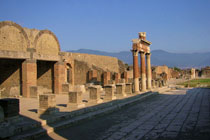Historical notes about Pompeii
By the 1st century, Pompeii was one of a number of towns located around the base of the volcano, Mount Vesuvius. The area had a substantial population which grew prosperous from the region's renowned agricultural fertility. Many of Pompeii's neighboring communities, most famously Herculaneum, also suffered damage or destruction during the 79 eruption. By coincidence it was the day after Vulcanalia, the festival of the Roman god of fire.Tourism in Pompeii
Pompeii has been a popular tourist destination for 250 years; it was on the Grand Tour. In 2008, it was attracting almost 2.6 million visitors per year, making it one of the most popular tourist sites in Italy. It is part of a larger Vesuvius National Park and was declared a World Heritage Site by UNESCO in 1997. The objects buried beneath Pompeii were remarkably well-preserved for almost two thousand years. The lack of air and moisture allowed for the objects to remain underground with little to no deterioration.
Where is Pompeii ?
 Where is Pompeii? Pompeii is in the Italian region of Campania, near Naples. Pompeii is close to the Bay of Naples. Other places in the area to visit are Capri and Sorrento.
Where is Pompeii? Pompeii is in the Italian region of Campania, near Naples. Pompeii is close to the Bay of Naples. Other places in the area to visit are Capri and Sorrento.
Romans took control of Pompeii around 200 BC. On August 24, 79 AD, the volcano Vesuvius erupted, buried the nearby town Pompeii in ash and soot, killing 20000 people, and preserving the city in its state from that fateful day. Pompeii is an excavation site and outdoor museum of the ancient Roman settlement. This site is considered to be one of the few sites where an ancient city has been preserved in detail - everything from jars and tables to paintings and people were frozen in time, yielding an unprecedented opportunity to see how the people lived two thousand years ago.
About Lucia

Pompeii Tour Guide Licensed English Français







